Using ADP to Generate Value
I don’t know as much as I think I do about fantasy football. That might seem like a dumb thing to say for someone trying to give you advice on the topic, but I really believe that embracing the uncertainty inherent to the game—accepting what we don’t know or what we think we know that could just be wrong—is essential to progressing as a fantasy owner.
Think back a few years and consider your fantasy football knowledge. How many beliefs did you hold that just turned out to be wrong? How many poor predictions did you make? How many times did you tell everyone who would listen that Trent Richardson was worth a top-four pick last year? Maybe that last one was just me. The point is that it would be irrational to think that all of our beliefs about the 2014 season are accurate—even the ones that seem undoubtable—and we just need to accept the fact that we’re going to be wrong. A lot.
That doesn’t mean that drafts are total crapshoots and you’re no more likely than your Aunt Debby to win your fantasy league, though. One way to stand out from the crowd is to embrace year-to-year volatility, knowing where the crowd is going to overreact to recent results to make drafts inefficient. By and large, current season ADP is more or less a reflection of the prior year’s results.
In this article, I’m going to compare 2013 fantasy results to those from the previous four seasons to see where last year might be an outlier. In siding with five-year trends as the basis for our rankings, we’re basically saying “I don’t know exactly how things will turn out this year, but I realize there’s variance on the seasonal level, and in that case, I’m best off just going with the long-term average.”
Quarterback
My favorite example of this type of inefficiency is 2012 ADP following the historic 2011 season for quarterbacks. You remember that year, right? A-Rod led the way, but there were five quarterbacks who produced at a level we’ve simply never seen before. To give you an idea of how much of an outlier that 2011 season was, consider that the top five quarterbacks recorded more fantasy points than all but one passer in the previous six years!
Below, I’ve broken down the fantasy point distributions for the top 12 quarterbacks over the past five seasons.
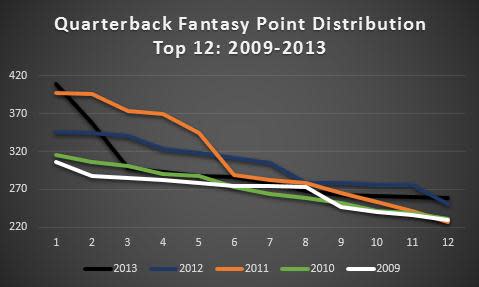
The 2011 season—in orange—is ridiculous. Heading into 2012 fantasy drafts, shrewd owners knew that others were highly likely to overpay for those top quarterbacks. That would deflate their value while also inflating the value at other positions. The merits of going against the grain in that situation are pretty obvious; such a contrarian strategy works because you’re buying low on positions that perhaps underachieved in the previous season.
Where’s the QB Value?
If you look at the 2013 distribution in black, you’ll see a massive drop after Peyton Manning. Those quarterbacks ranked second through sixth or so are getting drafted lower this year than in many other recent seasons. Although many experts are following the late-round quarterback strategy, I think there are times when it’s okay to jump on potentially elite passers in the middle rounds.
Specifically, if you can get Rodgers/Brees in the fourth round or Luck/Foles in the sixth or seventh, those are situations I think are very favorable—owners overcompensating for getting burned in the recent past. You probably won’t see quarterbacks drop like that in novice leagues, but when it happens in more advanced leagues, I think it’s difficult to pass on that sort of safety.
Running Back
Moving on to recent running back trends …
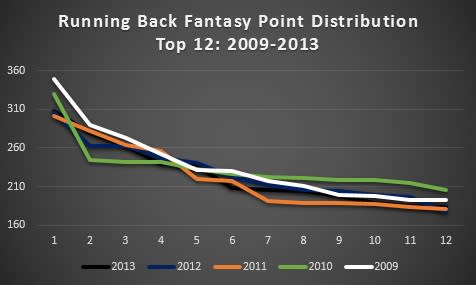
Note that one of the natural outcomes of analyzing point distributions is seeing the greatest fluctuations near the top. We’re never going to see the No. 12 running back in Year X differ from the No. 12 running back in Year X+1 by a crazy amount, but we might see the top running back’s fantasy production really shift from one year to the next.
You can such a deviation in the 2010 season; there was a really big drop from the top back, but then the production leveled out almost entirely from the No. 2 back to No. 12. The average drop from the No. 2 running back to No. 12 during the five years was 84 points with a high of 101; in 2010, it was just 38 points. In that situation, we’d need to be careful to realize that the 2011 running back distribution would be more likely to resemble long-term trends (with a greater slope) than the 2010 results—and you can see that did indeed happen.
Where’s the RB Value?
The 2013 season was typical in just about every sense of the word for running backs as a whole. So does that mean you should jump on backs in the early and middle rounds?
It depends. To understand where we need to go at the running back position, we need to analyze them in relation to wide receivers.
Wide Receiver
The wide receiver position has been interesting to follow lately because there’s been a clear upward trend for the position as a whole. While 100-yard rushing games have more or less remained constant over the past half-decade, the occurrence of 100-yard receiving games has increased by nearly 40 percent. Forty percent in five seasons!
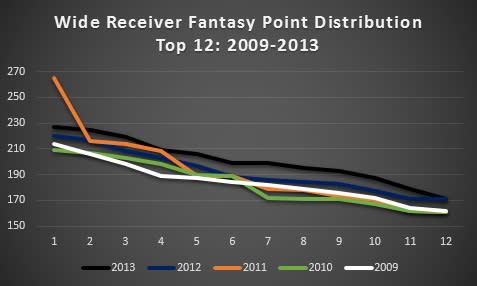
The 2013 distribution is very interesting because, although it’s very flat, the entire line is bumped up over previous seasons, i.e. wide receivers have been scoring more and more fantasy points. I don’t think that’s a fluke; we’re not looking at a handful of spots rising and the rest achieving as normal, but rather a unified leap for all wide receivers.
That doesn’t necessarily increase the value of wide receivers, though. That all comes down to your league’s scoring and starting requirements.
Where’s the WR Value?
Let me reiterate that: wide receiver value is strongly linked to your league’s scoring and starting requirements. The same goes for running backs.
Specifically, in PPR leagues that have at least one flex position, wide receivers have dramatically more value than in leagues that have either standard scoring or no flex position. The reverse is true for running backs; they’re more valuable in standard scoring leagues with no flex.
The key is the flex. It’s a massive inefficiency in the draft market and the No. 1 area I think you can exploit in your league. To help show this, I charted the number of running backs and wide receivers drafted after each of the first eight rounds in 2013 expert flex PPR leagues. Yes, experts drafting, but in a totally sub-optimal way.
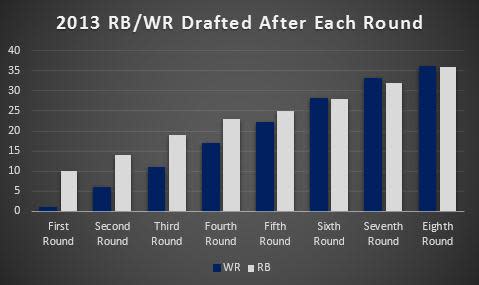
You can see the number of running backs drafted was higher than the number of wide receivers until the end of the sixth round, which is traditionally where the positions have leveled out, i.e. these numbers aren’t unique to 2013.
That would be one thing if running backs scored more, but after the top tier, they don’t.
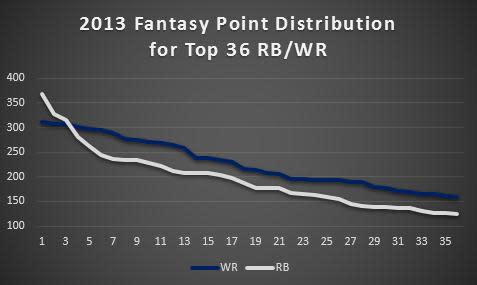
Again, this sort of trend is indicative of what we see every season, and the gap between backs and receivers is only widening. The elite pass-catching backs kill in PPR, giving them a ton of value. If you’re drafting in the top portion of the first round, you can pass up an elite back perhaps only for a Calvin-Johnson-esque player.
But after the first few players, wide receivers score more points than running backs relative to their draft slots in PPR leagues. That is, the No. 12 wide receiver almost always scores more than the No. 12 running back, the No. 24 wide receiver scores more than the No. 24 running back, and so on.
So wide receivers score more points than running backs (outside of the very elite backs), but they cost much less. Um, that’s good, right? We saw 10 running backs drafted in the first round in 2013, but the 10th wide receiver didn’t go until the back of the third round. Yet the No. 10 wide receiver actually outscored the No. 10 running back by 41 fantasy points.
Cha-ching!
So here’s what we are to make of all this: if you’re in a PPR league with at least one flex starter, wide receivers are going to be undervalued. You should basically be racing to fill your flex spot with a receiver, considering an early running back only if you have a top pick.
If you aren’t in a full PPR league and/or you don’t have a flex option, you might want to consider going heavy on running backs early. If you look at 2014 ADP, you’ll see far more of an early-receiver trend than ever before. The pass-catchers are still undervalued when there’s a flex, but they’re being drafted in the same spots when there isn’t a flex, creating value for running backs.
Tight End
And finally, let’s take a look at the progression of the tight end position.
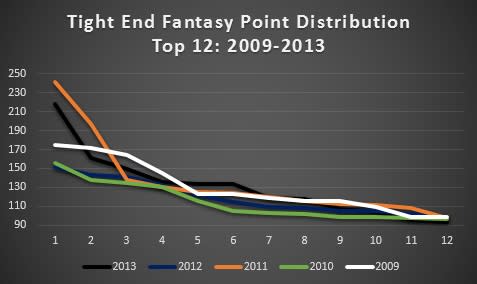
Tight end is unique in that there are a few elite pass-catchers—Jimmy Graham, Rob Gronkowski and perhaps a few others—who are so outrageously more talented than others at their position. That creates huge scarcity at the position (hence the steep declines in the chart), which is finally being reflected in drafts.
Where’s the TE Value?
Tight end is a position at which I’m either paying up for one of the big boys or else just waiting it out. Graham is an option, but I think that Gronkowski is a player who is cheaper with arguably more upside (and admittedly greater risk). I think Gronk’s ADP is going to rise as he continues to prove he’s healthy, but I’m a buyer anywhere from the middle of the second round onward. If I miss out or would prefer to fill my receiver spots, I’m basically going “Zero TE” unless someone like Jordan Cameron unexpectedly falls.
Summing It Up
The overall idea is that, because we probably don’t know as much as we think we know about fantasy football, it makes sense to analyze long-term trends to see where players at each position are likely to fall in a given season. When the past season deviates wildly from prior years, it’s a sign that there might be an inefficiency in the upcoming draft.
This year, I think the elite quarterbacks are dropping a tad too far in expert drafts. You still probably want to wait on quarterbacks in most drafts, but I’m buying Rodgers in the fourth and Foles in the seventh, especially.
Running back and wide receiver value is closely linked, with starting and scoring requirements dictating how you should play them. In PPR leagues with a flex position, wide receivers are drastically undervalued and provide a monumental ROI. Otherwise, it might be intelligent to be a contrarian this year, reverting to an “old school” running-back-heavy draft when so many others are starting WR-WR.
At tight end, it’s a tale of two extremes. The few sensational talents are worth consideration because of their remarkable scarcity, but otherwise you can probably stream tight end options off of waivers in an effort to reproduce second-tier tight end production.
